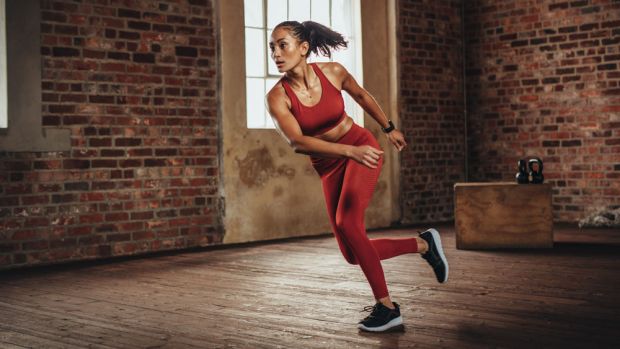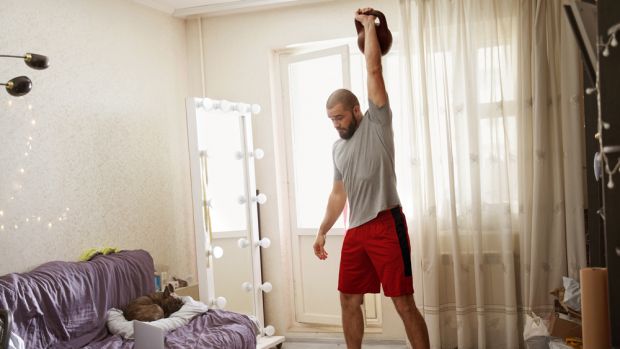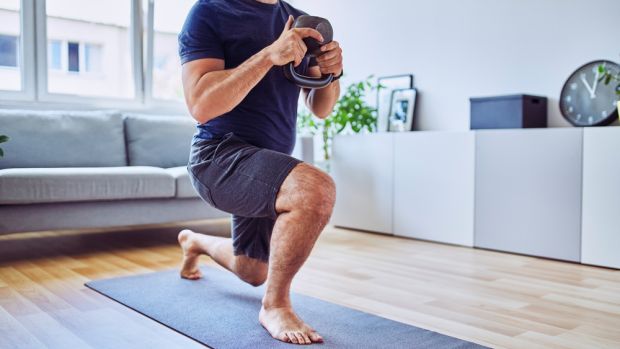The Best Home Exercises For All Levels
Get fit in your front room with these beginner, intermediate and advanced home exercises

Every workout environment has its advantages. Gyms are well stocked with every kind of fitness equipment along with experts who can guide you through your workout, while exercising in the great outdoors offers you the chance to get in touch with nature and enjoy some sun in the process. The main advantage of home workouts is that you don’t have to go anywhere for your exercise, saving time and ensuring you can slip in some training the moment you have the motivation.
If you are going to work out at home, however, you need to have a plan because it is highly unlikely that there will be a personal trainer standing by ready to tell you what to do (and if there is, do make sure you ask them what they’re doing in your house). So to help you get fit at home we enlisted Optimum Nutrition athlete Dom Heap for his picks of the best beginner, intermediate and advanced home exercises. We’ve added a few of our favourites, too.
Before we go into the exercises it’s important to remember that every home workout should start with a warm-up. Heap recommends five minutes of jogging on the spot followed by five 20-second rounds of star jumps, with 20 seconds of rest between each round. Then you’re good to go.
Most of the exercises below are bodyweight moves, but there are a few that use some basic equipment. Having a dumbbell, kettlebell, pull-up bar or resistance bands to hand enables you to increase the difficulty and range of exercises in your home workouts, so if you’re planning to do a lot of training at home it’s well worth buying some kit.
There’s been a stampede for home gym equipment during the COVID-19 lockdown, but there’s still plenty available: resistance bands in particular are cheap and easy to acquire, while kettlebells and pull-up bars still seem to be fairly widely stocked. Unless you require very light or very heavy dumbbells, though, you’ll be paying through the nose so maybe hold off on those until this is all over.
Beginner Home Exercises
Unweighted squat

“Stand with your feet shoulder-width apart and turn your toes out slightly,” says Heap. “Put your arms out in front of you and engage your abdominals while broadening your chest and gently pulling your shoulder blades together.
“Bend your knees slowly while pushing your hips and glutes out behind you as if you are about to sit down. Lower until your knees and hips are parallel, then push back up through your heels to the start position.”
Get the Coach Newsletter
Sign up for workout ideas, training advice, reviews of the latest gear and more.
Pike press-up

“Assume a press-up position with your arms straight and hands under your shoulders,” says Heap. “Walk your feet towards your hands, keeping your legs straight until you form a V-shape. Once in this position, slowly bend your elbows so your head goes towards the ground. Go as low as you can, then press back up, locking out your elbows.”
Crab walk

“Start by sitting with your hands on the ground planted behind your shoulders,” says Heap. “Raise your hips until both your hands and feet are flat on the ground. Once in this position, proceed to walk both forwards and backwards, making sure you brace your shoulders as you move.”
Dead bug
Who’d have thought that simulating the despairing limb-flails of an upturned insect could be so good for your core strength? The dead bug works both the upper and lower abs without straining your lower back, and is one of the best core-crunching moves beginners can do at home. Start lying flat on your back with your arms extended above you and your legs raised so your knees are directly above your hips and bent at 90°. Simultaneously extend your left leg forwards and your right arm behind you, keeping your back pressed into the ground and your core engaged. Bring your arm and leg slowly back to the start, then repeat with the opposite limbs.
Bird-dog

If you’re looking for simple exercises to counter the effects of sitting at a desk all day without the risk of making things worse, let us point you in the direction of the bird-dog. It might have a slightly silly name, but it will improve your core strength and it also benefits your lower back. Start on all fours with your hands directly under your shoulders and your knees under your hips. Slowly reach your right arm out in front of you while also lifting and extending your left leg behind you. Then bring both back to the starting position and repeat with the opposing limbs. Keep your movements controlled to gain the maximum benefits. As well as your core strength, the bird-dog also boosts your balance and co-ordination.
Plank

This simple hold should be one of the first exercises a beginner masters because it will do wonders for your core strength. It’s also ideal for those starting out at home because all you need is the space to lie still.
To do a plank, support your weight on your forearms and your toes, and form a straight line with your body from your shoulders to your heels. It’s all too easy to lower your hips too much or raise your rear too high. Get someone to check your form if you can, but failing that do it in front of a mirror so you can correct yourself. Perform the plank for a set period of time – for instance, three sets of 20 or 30 seconds.
Donkey kick

This simple move is a particularly good glute-strengthener, but it also works your core, lower back and hips. Start on all fours with your hands under your shoulders, and your knees and feet hip-width apart. Squeeze your glutes and raise one leg behind you, keeping the knee bent at a 90° angle, until the sole of your foot faces the ceiling, then bring it back down slowly. Make sure the rest of your body is completely still while you raise the leg – letting your hips sag is a common mistake that reduces the move’s effectiveness.
Wall sit

The wall sit is ideally suited to being done at home because you don’t need to get in any kit at all (we’re assuming your domestic setting features walls of some kind). Put your back against the wall and slide down so that your knees are at 90° and your feet are flat on the floor. Now do nothing for as long as you decide to hold the rep – somewhere between 20 seconds and a minute should be as much as you can bear first time around. This isometric hold will do wonders for your lower body, especially your thighs. If you want to make things harder, take one foot off the ground. Even harder? Hold a weight in front of you with your arms outstretched or above you.
Intermediate Home Exercises
Plank raises

“Start in an elevated plank or top press-up position with your arms straight and elbows locked,” says Heap. “Making sure you’re looking forwards, slowly raise one arm out in front of you, bringing it up to eye level. Then lower it without planting it back on the ground and repeat the movement until you have to stop. Then do the same on the other arm. You can also try raising your arms to the sides as well as forwards.”
Resistance band squat press

“Stand with your feet shoulder-width apart,” says Heap. “Step on one side of the resistance band and grasp the other side of the band with your palms facing up and out. Bring the band up until your hands are in line with your shoulders with your elbows bent. This is your starting position.
“Squat down until your knees and hips are parallel to the floor, then push back up and press the band overhead until your arms are extended. Bring the band back down to the starting position in a controlled manner and repeat, making sure your feet stay in place throughout the movement.”
Burpee
“Start off in a low squat position with your hands on the floor, then kick your feet back so you’re in a press-up position,” says Heap. “Complete one press-up, bring your feet back into the low squat position, and jump as high as you can.”
Triceps bench dip

While you might not have a dip station in your home, you will have a suitable surface for this move – a table or chair works just fine. (You have a table or chair, right?) Facing away from the surface, place your hands on it behind you, with your feet together on the floor and your knees bent. Lower your body until your elbows are bent at 90°, then press back up until your arms are straight. To increase the difficulty, straighten your legs or place your feet on an elevated surface as well.
Skater jump

This plyometric move works the muscles in your legs and glutes, and will also improve your balance and co-ordination. From standing, push off your left foot to leap to your right, landing softly on your right foot with a bent knee. As you land, bring your left foot behind your right leg, keeping it in the air if possible – let it touch the ground if your balance is going. Pause for a beat, then leap back in the opposite direction, swinging your right foot behind your left leg. The further you leap, the harder the skater jump is, so shorten your bounds if you’re struggling to keep your balance at first.
Side plank

This plank variation complements the classic move by focusing on the obliques muscles – the ones found to the sides of the central abs. Start lying on your side propped up on your forearm, with your hips, legs and feet stacked one on top of the other. Lift your hips so you form a straight line from your neck to your feet and hold this position. You should feel the burn in the side of your midsection. Then swap sides.
Bicycle crunch

If you want to work on your abs at home, stop doing standard crunches and do the bicycle crunch instead. It’s among the most effective moves you can do because it hits the lower abs, the upper abs and the obliques all in one exercise.
Lie on your back with your hands touching the sides of your head and elbows pointing out to the sides. Lift your head and shoulders slightly off the ground, then raise and extend one leg while bringing the other knee up to your chest. As the knee rises, twist your torso so the opposite elbow comes towards the knee – they don’t have to touch. Make sure you’re not twisting your head to move the elbow – the twist should be in your torso and powered by your core. Lower the leg and elbow at the same time, and then repeat the movement with the opposite limbs.
Mountain climber

It may be easy to master, but this full-body exercise is versatile enough to put it in the intermediate bracket. Place your hands on the floor directly beneath your shoulders, arms fully extended, with your toes being the only other contact point to the ground. Your body should form a straight line from your shoulders to your heels. If you’re struggling to do this, take a step back and use the plank to firm up your core first.
Once you’re set up, bring one knee towards your chest, leaving your other foot planted on the ground for support, then return it to the starting position and bring your other knee to your chest.
Whether you perform the move slowly and deliberately or at pace is up to you. The faster you go the harder your heart will work, giving you a cardio workout, while slower movement holds greater benefits for your core and abs.
Press-up

A staple of any home workout once you’ve reached a middling level of fitness, a press-up with good form will not only work your chest, triceps and shoulders, but tax your glutes, core and legs as well.
Place your hands on the floor directly below your shoulders – the only other contact point with the ground should be your toes. Keep your legs straight and ideally together – moving the legs apart is a means of making the press-up easier. Once your hands and feet and in position, ensure your body is straight by bracing your glutes and core to keep your frame stable. Lower slowly, ensuring your elbows are tucked in, until your chest is around 2cm from the ground, then push up until your arms are fully extended. Try to take one second to push yourself up, but three seconds to lower.
Leg raise

This exercise is a mean one on the abs, so brace yourself for a bit of a burn. Lie on your back with your arms by your sides and legs stretched out. If you need to, use your arms for support, and if you’re on a hard surface – which we don’t recommend; a gym mat is a worthwhile investment if you plan on adding this to your regular routine – place your hands between your coccyx and the floor to protect your spine. Keeping your back and legs as flat as possible, and your core engaged throughout, raise your legs until they point towards the ceiling (or as far as you can go while keeping your back straight), then lower again as slowly as you can.
See related
- The Ultimate Home Workout Plan
- The Best Bodyweight Exercises For All Levels Of Gym-Goer
- The Best Home Gym Equipment
- The Best Exercise Mats For Your Home Workouts
Advanced Home Exercises
Kettlebell swing

“Stand with both hands on the kettlebell,” says Heap. “Lower yourself into a squat position and allow the kettlebell to swing slightly back between your legs, then explosively drive your hips forwards, swinging the kettlebell out in front of you. Engage your core and glutes throughout the movement. The kettlebell should come up to around eye level, then control the swing down and repeat the movement.”
Kettlebell press

“Start by holding the kettlebell in one hand at shoulder height,” says Heap. “Let the kettlebell rest on your forearm and keep your elbow close to your body. Make sure your feet are firmly planted on the ground to provide stability. Brace your abs and glutes, then drive the kettlebell up over your head, fully extending at the elbow. Bring the kettlebell down slowly and repeat. Do all reps on one arm, then switch to the other.”
Kettlebell jump lunge

“Hold the kettlebell with both hands next to your chest and stand tall,” says heap. “Step forwards on one leg, lowering your back knee into a lunge position. Drive up with both legs and jump. Switch your legs while airborne and land on the ground in the lunge position with the other leg forwards.”
Hollow-body hold

The hollow-body isometric hold is brilliant for your core, but boy does it hurt. Even if you already have a strong core and can hold a plank for three minutes, you might struggle to make it to 60 seconds in the hollow-body hold position. The good news is that even if you give up after 30 seconds, you’ll have increased your core strength – and that’s what it’s all about.
Lie on your back with your legs together and your arms extended behind your head. Lift your arms, shoulders and legs off the floor at the same time. They should hover about 15cm above the floor, while your lower back remains pressed into the floor throughout. Now hold for as long as you can.
Burpee pull-up
Burpees are no-one’s friend, but a burpee pull-up is just a straight-up bully. Stand beneath a pull-up bar, drop to the ground and complete the standard burpee movement. Once you’re back to standing, jump up and grab hold of the bar. Complete one controlled pull-up, lowering slowly to a dead hang, then return to standing. That entire action counts for one rep. HAVE. FUN.
Diamond press-up
What seems like a small change makes a press-up much more difficult by moving the focus away from your chest and to your triceps. Rather than placing your hands directly under your shoulders, bring them together, with your forefingers and thumbs touching so they form a diamond shape on the floor. Keeping your elbows tucked in to the sides of your body, lower slowly until your chest is as close to the ground as possible without touching it. Then push back up powerfully.

Nick Harris-Fry is a journalist who has been covering health and fitness since 2015. Nick is an avid runner, covering 70-110km a week, which gives him ample opportunity to test a wide range of running shoes and running gear. He is also the chief tester for fitness trackers and running watches, treadmills and exercise bikes, and workout headphones.
